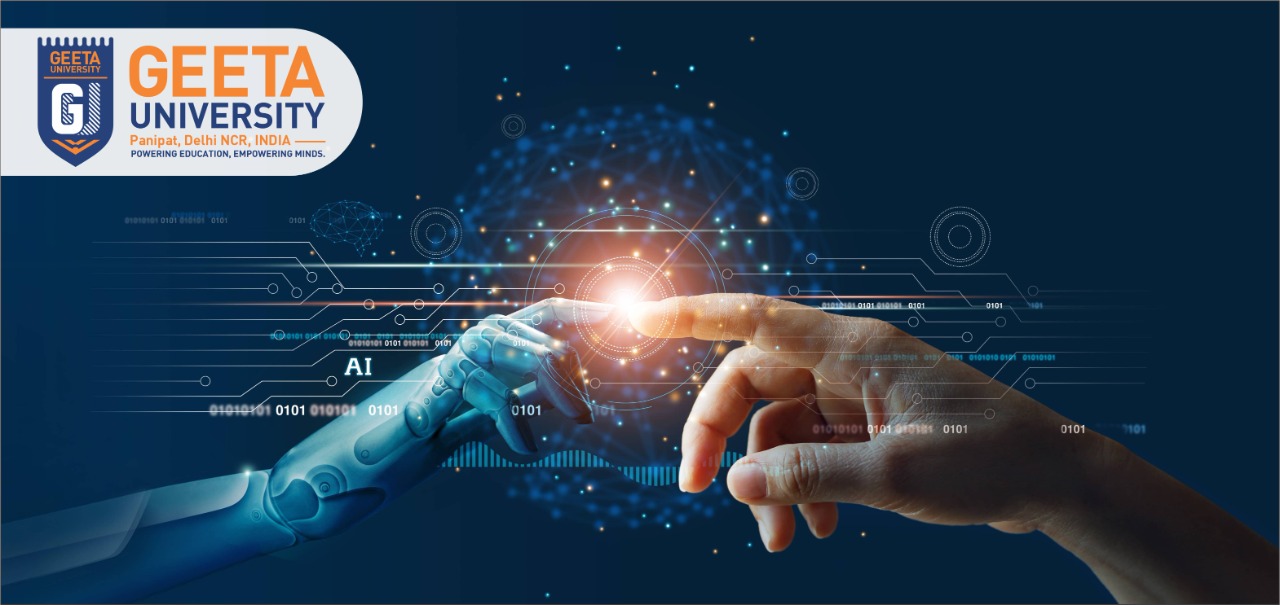
Unlike humans, AI learns and excels at a limited number of tasks. Weak or thin AI is the name given to such associate AI. They are currently typically superior to humans in their field.
Artificial intelligence: AI Terms Simply Explained – Geeta University
Artificial Intelligence
John McCarthy, one of the founding fathers of AI, defined AI as “the science and technology of making intelligent robots,” which is a subject of study for scientists and engineers.
Currently, the phrase generally refers to intelligent devices that: Portable computer systems that behave intelligently are referred to as AI.
Weak/tight AI
Unlike humans, AI learns and excels at a limited number of tasks. Weak or thin AI is the name given to such associate AI. They are currently typically superior to humans in their field. All of today’s AI systems are ineffective.
General / sturdy AI
However, an AI with human-like intelligence that can apply its thoughts to a variety of different jobs does not yet exist. However, it is the most important goal of AI research. General AI is the name given to this type of associate AI. The terms sturdy or true AI are commonly used, but their philosophical origins make them less clear.
Super-AI
Artificial super intelligence emerges if general AI evolves to such a degree that it surpasses what people generally respect. The development of a KSI — especially because of the singularity — signifies the most likely end of humanity, according to some AI warner’s. On the other hand, other AI experts believe that super AI will be able to solve humanity’s most pressing problems, such as action, standing, and disease.
How to manufacture AI
There are a variety of ways to create AI. Essentially, two fundamentally distinct techniques are distinguished:
Until the late 1980s, the so-called “Good, old school AI” (GOFAI) dominated AI research and aimed for solid AI. The concept: Human thought is made up of a logical synthesis of separate concepts that hold our knowledge of the world.
Machine Learning (ML)
Machine learning, particularly deep learning, is the current AI analysis favorite.
Machine learning produces portable computer systems that use data to tell them what to do in order to complete tasks. Rather than a developer administrative unit specifying directions line by line in the planning of programming code, the computer code repeatedly updates and optimizes its code after the primary trigger.
Deep learning is said to be the current favorite of the analysis discipline: machine learning with multi-layered neural networks that recognize patterns in data with growing accuracy and so understand human preferences, recognize objects, or perceive language.
The academic degree outsized style of modern AI services is driven by machine learning. Whether it’s Google, Netflix, or Facebook, learning algorithms provide recommendations, improve search engines, and allow voice assistants to answer questions.
(Artificial) Neural Networks
A primitive representation of the human brain inspires artificial neural networks: a formula builds fully distinct layers of connected neurons or nodes that exchange data with one another.
The architecture consists of an associate input layer, a middle, hidden layer (hidden layer), and an associated academic degree output layer in the simplest scenario. The signal is altered and passed on to the output layer by the initially haphazardly generated values of the central neurons.
Deep Learning (DL)
Deep learning, often known as deep learning, is a type of machine learning that uses neural networks with multiple hidden layers (Hidden Layer).
These powerful neural networks began their triumphant march in 2012, when one of them won the Image Net image analysis competition.
Deep learning is to blame for the recent AI explosion, particularly in image recognition, autonomous driving, and deep fakes.
Deep learning’s breakthrough is made possible by ever faster processors and dedicated AI chips like Google’s TPU, as well as vast amounts of data used to train the machine rains, training, and lots of other things. Coaching is also an area of AI, similar to placeholders in mathematical calculations. However, how you learn and train is entirely dependent on AI. I’ll show you several learning methods that are employed in AI coaching.
Supervised learning
The AI has monitored inside the sense that its coaching information is ready with supervised learning. For instance, if an AI needs to recognize items in images, all cats, vehicles, trees, and other objects are marked on the coaching photos before the coaching.
Unsupervised learning
The hope of AI analysis is unsupervised learning. In contrast to supervised learning, information isn’t prepared in a sophisticated manner: AI receives enormous amounts of data without labels and searches for patterns within the knowledge multiple times.
The strategy has two advantages: it is uncommon to find initial, well-prepared, intensive information sets. Second, association AI will reveal hidden correlations in data that people are unaware of.
Conclusion
“If intelligence is additionally a cake, the majority of the cake is unattended learning, the frosting on the cake is supervised learning, and the cherry on top is reinforcing learning,” says AI expert Yann Lecun.
- By Shallu Pahal
- June 10, 2022
Related Posts
The Future of Artificial Intelligence in Healthcare
Introduction Artificial Intelligence (AI) in healthcare refers to the application of advanced technologies such as machine learning, natural language processing, and robotics to analyze complex

Nanotechnology in Drug Delivery system
Introduction: Drug development and delivery encompass the process of discovering, developing, manufacturing, and administering therapeutic agents to treat or prevent diseases. It involves interdisciplinary collaboration

Data Privacy
Introduction In an era dominated by digital interactions and interconnected technologies, the concept of data privacy has emerged as a critical concern. As individuals, businesses,


